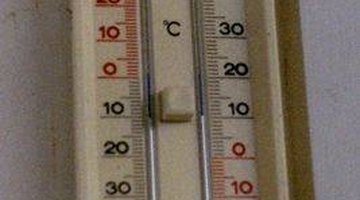How to Test a Bimetal Thermostat
A bimetal thermostat is an electrical component used in furnaces and other devices that are turned on and off based on the ambient temperature. There are several variations of the bimetal thermostat, including the coiled thermostat that is common in some dial household thermostat controls.

Things You Will Need
- Hair dryer
- Extension cord
There are others that are simple strips with one type of metal on top and another type on the bottom. These different metals expand at different rates when the temperature rises. For a coiled bimetal thermostat, the metal on the inner side of the coil expands more, causing the coil to partially unwind and the temperature needle to move to the right. For a strip bimetal thermostat, the metal on the bottom expands more, caused the strip to bend upward, breaking an electrical contact, which would turn off the furnace in a household application.
-
Locate the bimetal thermostat. For a furnace, it is usually found where the temperature control in the house is located. If you are checking the bimetal thermostat in another device, consult the owner's manual for the thermostat's location.
-
Turn on the furnace or device and adjust the temperature control to turn it on. For a device other than a furnace, you can check visually if the bimetal thermostat responds correctly to heat by watching the coil unwind or the strip bend up.
-
Plug in the hair dryer and aim the flow of heat at the bimetal thermostat. Check for the correct response, which will be unwinding or bending. If the response is correct and the furnace is not turning off, or your other electrical device is not operating correctly, the problem lies elsewhere.
-
Replace the bimetal thermostat if it does not respond correctly to heat. You can sometimes conduct a visual check of the bimetal thermostat and look for separation of the two metals, which would render it defective.
-
Turn the hair dryer off and unplug it.
Tip
It can take more than a few seconds for the bimetal thermostat to respond to heat, so don't be impatient.
Warning
Use caution when working near household AC voltage, which can cause electrical shock.
Tips
- It can take more than a few seconds for the bimetal thermostat to respond to heat, so don't be impatient.
Warnings
- Use caution when working near household AC voltage, which can cause electrical shock.
Writer Bio
Doug Hewitt has been writing for over 20 years and has a Master of Arts from University of North Carolina-Greensboro. He authored the book "The Practical Guide to Weekend Parenting," which includes health and fitness hints for parents. He and his wife, Robin, are coauthors of the "Free College Resource Book."
Photo Credits
- Wikimedia Commons
- Wikimedia Commons
More Articles



